ED BABINSKI: It is not true that "snakes are the only vertebrates without legs."
Besides snakes (which are reptiles without legs), there are species of long snake-like AMPHIBIANS that also lack legs. (Kind of like long snake-like newts without legs.)
There are also some species of reptiles and amphibians with long snake-like bodies and TINY LEGS. (Were they only "half cursed" according to the Bible?)
Of course those snake-like amphibians aren't even mentioned in the Bible.
There are probably no mammals without legs for the simple reason that the mammalian body couldn't move without appendages, the segementation of the abdominal region that provides propulsion is perhaps not as well suited for propulsion in mammalian bodies as in amphibian and reptilian snake-like bodies.
Google "legless amphibians"
Caecilian- Leg-less amphibian in the order Gymnophiona
A short excerpt from a thesis (the whole thesis is nearly 200 pages long) on how lizards may change into snake-like creatures. WITH PHOTOS!
Greetings.
I have been asked to send print quality version of the following pictures of a ball python's spurs. The larger pictures are in the attached zip file, spurs.zip.
The name of the snake is Peton, she is an adult ball python, Python regius, a pet snake. If you use the pictures, you may say they are used with permission.
Regards,
MBaumeister
North Carolina
members.aol.com/mbb386
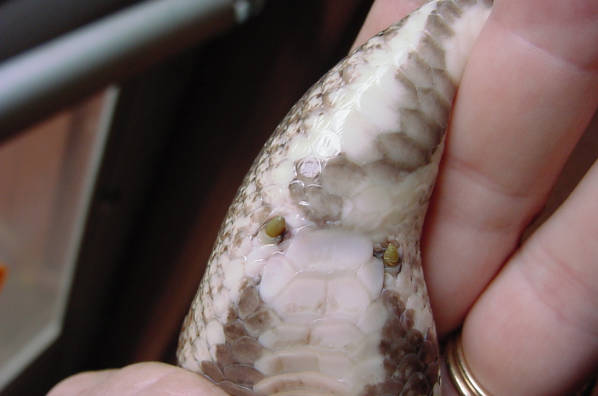
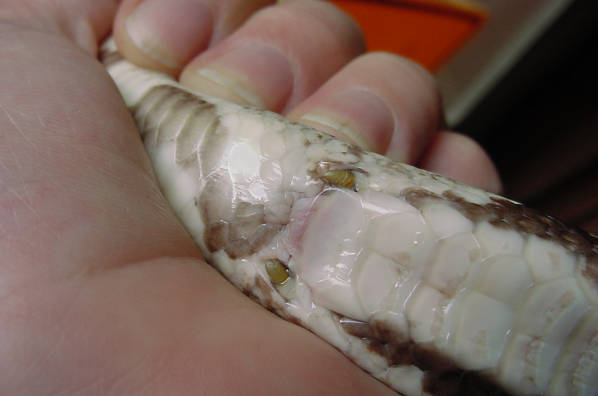
Aug 20, 2005
Peton the Python is alive and well. She recently had a good shed followed by a nice rat for supper. At the moment she is sleeping in her hidebox - she'll be up and about this evening late! :)))
Regards,
MBLENNY FLANK WRITES: "As an aside, we now know, from genetic analysis, why snakes don't have vestigial FRONT limbs. During the evolutionary appearance of snakes, there was a change in one of the HOX genes that shifted the body plan forward a bit. As a result, snakes now have no neck vertebrae --- they are all thoracic and abdominal. Since, genetically, front limbs appear right where the cervical vertebrae begin, snakes can't have front limbs. The vestigial rear limbs appear where the abdominal vertebrae meet the tail. As photos show, the tail of a snake is extremely short. So, even though a snake LOOKS like it is all neck or all tail, in reality, it is all body."
Creation "Science" Debunked
My Reptile PageAquaGenesis by Richard Ellis available at amazon.com
Excerpts from Page 139
During the great Age of the Reptiles, group after group returned in part or as a group to the sea. Among the most ancient of reptile groups, the turtles produced the familiar sea-dwelling forms. So did the crocodiles (in the teleosaurs), and so did the lizards (in mososaurs). Most completely marine of the extinct groups were the ichthyosaurs and the plesiosaurs, the former with a startingly fishlike body form, and the latter like gigantic turtles with vastly elongated necks. Among existing reptiles, the snakes have in their turn produced a true sea snake, but as this is confined to the tropics, it is little known outside of zoological circles. Far more remarkable even than the sight of a whale is the occasional encounter in the Pacific or Indian Ocean with an aggregation of sea snakes.
-- Schmidt and Inger
Living Reptiles of the WorldExcerpts from Page 151
"It is not evident whether snakes evolved as aquatic animals and then some came out on land, or whether they are land animals, some of which returned to the sea. Traditionally, the earliest reptiles are thought to have emerged from the water, eventually to evolve into lizards, turtles, crocodiles, dinosaurs, snakes -- and maybe birds . . . The legs of these returning reptiles were modified into flippers. The terrestrial snakes, however, had no legs to modify, so if some snakes became aquatic, the major morphological change involved the flattening of the tail, to allow for more efficient movement through the water, and a modification of the breathing apparatus."Excerpts from Page 152
"In the chapter on evolution in Australian Snakes: A Natural History, the biologist Richard Shine wrote (1991), "Partly because of the scarcity of good fossils, the classification of snakes is a mess. The difficulties are compounded by the fact that snakes have very simplified bodies, and there are not too many external characteristics upon which to base a classification: they look too much alike." . . .
In 1966, commenting on the confused and inconclusive state of the study of snake evolution at that time, Alfred Sherwood Romer wrote, "In contrast to the extinction or seeming evolutionary stagnation of other reptile types, the snakes are today a group of reptiles still 'on the make'." Minton and Heatwole (1978) wrote, "There seems to be little doubt, that [snakes] evolved in the region between northern Australia and the peninsulas of southeast Asia, a region that still harbors the greatest number and variety of species." The same authors wrote, "The snakes appeared late in the Mesozoic, and there is some evidence that, quite early in their history, they produced some huge marine species. Apparently these giant sea snakes were not very successful, for they endured but a short time and left a very scanty fossil record." According to sea snake expert Harold Heatwole, "Other snakes from the Cretaceous are known only from incomplete fossils and as no good skull material exists the most that can be sadi of the is that they were snakes with some characteristics intermediate between those of lizards and modern snakes." (Sea Snakes, 1999.)
The earliest snakes had an elongate body, reduced limbs, and adaptations for chemosensory hunting.. They are descended from lizards, and manifest many lizard-like characteristics. In 1997, Cladwell and Lee published a description of Pachyrhachis problematicus (from pachys, "thick", and rhachis, "spine"), a fossil snake that was found in the limestone quarries of Ein Yabrud, some 12 miles north of Jerusalem. Although it was certainly a snake, it had tiny hind legs consisting of femur, tibia, fibula, and tarsal bones, as well as other characteristics that provided "additional support for the hypothesis that snakes are most closely related to Cretaceous marine lizards (mosasauroids)." It was later determined that a fossil snake known as Ophiomorphus, also from the quarries at Ein Yabrud, was actually another specimen of Pachyrhachis problematicus, and though neither skeleton was complete, scientists had enough material to postulate the snake's morphology and relationships. . .
Excerpts from Page 153
Lee, Bell and Caldwell (1999) "indicate that the nearest relatives of snakes are the Mosasauroidea, medium to gigantic marine lizards .... The most basal ('primitive') snakes are the Cretaceous forms Pachyrhachis and Dinilysia, along with the living blindsnakes." Dinilysia, discovered from the Cretaceous of Argentina, "has inspired and challenged efforts to understand snake origins. The single well-preserved skull exhibits such a blend of snakelike, lizardlike, and unique characteristics that herpetologists still argue about whether this creature was indeed a snake" (Greene 1997). It would appear that snakes and mosasaurs are "sister groups," which means that they have a common ancestor that they do not share with any other animals, and that ancestral group split into two distinct lines, one of which evolved into mosasaurs while the other became snakes. . .
Excerpts from Page 154
Since Minton and Heatwole bemoaned the lack of primitive snake fossils, fossils of their "giant marine snakes" have begun appearing, but, as with many things paleontological, newly unearthed fossils often confuse rather than clarify things. . .
. . . The fossil Haasiophis was about 3 feet long and also had legs, but its jaw structure suggested to Tchernov et al. that it was more closely related to the larger, living snakes of today and that both Pachyrhachis and Haasiophis were not primitive at all, but advanced snakes that had re-evolved legs. (Many living pythons retain rudimentary hind limbs, so re-evolving limbs is a possibility.) The limbs of Pachyrhachis and Haasiophis are too small in relation to body size to have had any locomotor function; they may have been used as an aid in mating, as are the hind limb buds of pythons today.
Excerpts from Page 155
. . . None of this discussion addresses what to many is the fundamental question about snake evolution in the first place: Why should an animal with legs evolve into one without them? Legs seem to be quite a useful bit of equipment; every other terrestrial vertebrae has them. Only the fishes are legless; the whales, to adapt to the fishes watery environment, have lost their hind limbs completely and their forelimbs have evolved into paddles. Perhaps the sea snakes are a more advanced form of snake, for only in aquatic animals does leglessness confer an advantage -- or at least, it does not handicap the animal. . .
Excerpt from Page 158
Our understand of snake evolution is still fragmentary. In 1999, Scanlon et al. wrote, "The origin of snakes from lizard-like ancestors was a major event in vertebrate evolution, and remains poorly understood despite much effort." Although the fossil record is too sparse to make any definitive statements (always dangerous in paleontology anway), many paleontologists have done exactly that. After two groups of scientists examined fossil snakes from the same area, two scenerios emerged. Scanlon, Lee, and Caldwell have proposed that snakes are derived from water-dwelling lizards (mosasaurs), and emerged from the water to become the terrestrial species that we know today. As for the sea snakes, these writers say that they are simply land snakes that returned to the water and developed adaptations that enabled them to function more efficiently as aquatic animals. In their 1999 study of Pachyrhachis, Scanlon et al. said that it was "the most primitive snake [and] an excellent example of a transitional taxon, exhibiting most, but not all, of the derived features that are diagnostic of snakes." In their reconstruction, they show a large-bodied snake with a tiny head, miniscule hind limbs, and a short tail section. . . The other group of scientists, Tchernov et al. (2000), believe that modern snakes are the descendants of small, burrowing, terrestrial lizards.
. . . As for the legs, which Scanlon et. al. cited to demonstrate that snakes are descended from lizards, all they mean to Tchernov's group is that ancestral lizards lost their legs, became snakes, evolved into snakes with legs, and as of now have become (mostly) snakes without legs. They acknowledge that this is a less parsimonious explanation, but it nevertheless "remains a possibility, given the incompleteness of the fossil record of snakes and the recognition of multiple loss of limbs among squamates in general."
- End of Excerpts
Argument About Snake Evolution Rekindled by Fossil
March 16, 2000 By Patrick Rizzo
NEW YORK (Reuters) - Did snakes first slither onto land from the sea, or did their ancestors first evolve on land? That's one of the questions a fossil snake with legs has raised for scientists who thought they had already sorted out the origin of serpents. The snake fossil, found more than 20 years ago in a limestone quarry near Jerusalem, represents a new species, according to researchers writing in the current issue of the journal Science. "Haasiophis terrasanctus" -- named after Hebrew University paleontologist George Haas who bought the fossil from a West Bank quarry -- was about three feet long (0.9 meters) and lived in the shallow waters of a Cretaceous sea that covered part of the Middle East during the days of the dinosaurs. It is the second limbed snake to come from Ein Yabrud, a 95 million-year-old bed of sedimentary rock that also yielded "Pachyrachis problematicus," another important fossil with clues to the origins of snakes. Scientists believe that modern snakes are descended from lizards and that they lost their limbs over time. Remnants of these limbs can still be found in the anatomy of boa constrictors and pythons, just as the remnants of tails can be found in human anatomy. But a description of Haasiophis by Olivier Rieppel of the Field Museum in Chicago, Eitan Tchernov of the Hebrew University of Jerusalem and other colleagues writing in the journal Science has researchers once again puzzling whether snakes evolved from sea-going lizards, or from lizards which lived in seashore burrows. "That question has been around for a long time," Rieppel said in a telephone interview. In the 1970s, when Haas first described Pachyrachis, he thought that the well-developed hind limbs and advanced skull characteristics meant that the fossils weren't from snakes at all. Instead he thought they were reptiles related to a species of huge ocean-going Cretaceous lizards called mosasaurs.Then in 1997, certain features in Pachyrachis' skull led scientists to put it at the root of the snake's family tree as a sort of "missing link" between mosasaurs and true snakes that at some point took to the land. Rieppel and his colleagues now argue that traits found in Haasiophis and Pachyrachis are more akin to those of modern snakes, like the ability to unhinge their jaws to eat things larger than their heads. Such traits, the scientists say, mean that they are more closely related to modern snakes. So they "cannot be related to primitive mosasaurs," Rieppel said. Rieppel believes the ancestors of modern snakes were burrowing lizards that lived on land, but he acknowledges that the West Bank fossils do not provide clear answers to the question. Worldwide there are about 2,700 different species of snakes, very few of which are marine animals. "And so we are back to not knowing what kind of an origin snakes had," Rieppel said. Dr. Harry Greene, professor of ecology and evolutionary biology at Cornell University, said the most intriguing aspect about the West Bank fossils is they may show that certain "atavistic" traits can re-evolve if the right genes are triggered. The West Bank fossils may be snakes whose limbs re-evolved, making them "real snakes, just extinct real snakes" with legs, Greene said. Greene postulates that if animals like the West Bank fossils could re-evolve limbs, then other animals that have certain genes they never lost but whose "triggers" are dormant could re-evolve those traits. Maybe humans will end up with tails again.
Venom common, predates snake evolution
....By personally catching and milking thousands of snakes around the world, Dr Bryan Fry from the Australian Venom Research Unit at the University of Melbourne has shown that even snakes that we think of as non-poisonous have a venomous bite.... Perhaps even more surprising, Fry has found that venoms have been evolving a lot longer that the snakes themselves. "Snake venom developed only one time in evolution, a few hundred million years ago," he said.
To test this theory, he analysed the 'saliva' of an archetypal 'non-venomous' snake, the ratsnake, to see how far back venom components started in the evolution of snakes. The ratsnake, which is commonly sold in pet stores around the world, contained the same toxins as a cobra or death adder, and the toxins were just as potent....A large part of my research time is spent examining the molecular evolution of venoms. What I am studying is how venoms change with time, not just short time scales like variations between different populations of a particular species but also deep time changes occuring over millions of years and even going back to the original snake venom.
What we've discovered is that snake venom developed only one time in evolution, probably sometime during the Tertiary period over 60 million years ago.. This means it occurred right at the very base of the Colubroidea (Advanced snakes) evolutionary tree. The first venomous snake evolved from the heavy bodied swamp monsters similar to the anacondas of today. They needed a new tool to kill their prey since they were trading in the heavy muscle in order to become quicker and more athletic. Enter venom. They used this venom to feed on the cute little furry rodents that eventually became us.
Evolution of Snakes by Lenny Flank
The evolutionary advance that set the reptiles apart from the amphibians was the development of the amniote or shelled egg which could be laid on land, freeing the reptiles from the necessity of returning to the water as adults for reproduction. The oldest known fossil egg was found in Texas, and dates to the lower Permian period of the earth's history, over 275 million years ago. It is not known from which particular group of Labrynthodont amphibians the reptiles developed; several different families of ancient amphibians seemed to have been developing characteristics at the time similar to those of reptiles.The Evolution of Venom as a Weapon in Snakes by Lenny Flank
One family of the colubrids, however, added a new twist to the snake's survival arsenal. About 15 million years ago, snakes began appearing which had a number of greatly enlarged teeth at the rear of their jaw. These teeth had shallow grooves running down one side. Today, such snakes are referred to as opisthoglyphs or "rear-fanged" snakes. In the rear-fanged snakes, the enlarged teeth are used to pierce the skin of prey after it has been seized and partially swallowed, allowing venom (composed of highly modified saliva) to flow out of the Duvernoy's gland and dribble down the grooved teeth into the wound. Since it is difficult for these snakes to inject their venom until after they have partially swallowed their victim, it is unlikely that the snake's venom apparatus was originally developed as a defensive weapon. More probably it appeared as an effective way of quickly killing and subduing food. A large number of rear-fanged snakes are still alive today.
Shortly after the opisthoglyphs appeared, another group of snakes developed a more refined venom apparatus. These snakes are known as proteroglyphs, and are classified as the Elapids. Instead of having fangs at the rear of the jaws, the proteroglyphs have short fixed fangs which have migrated (by reducing the size of the maxillary bone) to the front of the mouth, where they can be used to bite and strike at enemies as well as food. The grooves in the fangs have become deeper and meet at the edges to form a hollow tube. These hollow fangs are connected to venom glands in the cheeks, which can inject venom through the fangs like hypodermic needles when the snake bites. Living descendants of the Elapids include the cobras and the sea snakes.By about 10 million years ago, the most highly specialized of the snakes appeared in the fossil record--the solenoglyphs, commonly known as vipers. In the vipers, the fangs are extremely long, much larger than in the Elapids. In fact, they are so long that the snake cannot close its mouth if they are erected. Thus, the solenoglyphs use a rotating maxillary bone to fold the fangs up against the roof of the mouth, where they are ready to spring into position when the snake bites. A short time after the vipers appeared, a group known as the pit vipers developed a number of heat-sensitive pits on the front of the face, which they used for finding their warm-blooded prey at night (this feature has also been independently developed by the venerable old Boid family). Finally, just a few million years ago, a group of pit vipers developed a structure at the end of their tail, made up of interlocking pieces of unshed skin, which could be loudly rattled and used as a warning device against predators. The rattlesnakes are generally thought to be the most specialized of all the living snakes.
The Evolution of Egg-Laying vs. Live Birth by Snakes by Lenny Flank
The evolutionary advance that set the reptiles apart from the amphibians was the development of the amniote or shelled egg which could be laid on land, freeing the reptiles from the necessity of returning to the water as adults for reproduction. The oldest known fossil egg was found in Texas, and dates to the lower Permian period of the earth's history, over 275 million years ago. It is not known from which particular group of Labrynthodont amphibians the reptiles developed; several different families of ancient amphibians seemed to have been developing characteristics at the time similar to those of reptilesEvolution of Viviparity
Although most reptiles reproduce by laying eggs, more than 100 separate lineages have evolved live birth (viviparity). Thus transition has usually occurred in cold climates. We have worked extensively on the origin of this trait, and especially on the selective forces involved. Current research by Rick Shine and Melanie Elphick focuses on the upper elevational boundary to egg-laying lizards in the Brindabella Mountains near Canberra. We have monitored natural nests of skinks (Bassiana duperreyi) for several years, and relocated eggs among nests to deconfound genetic and environmental influences. In current work we are examining the fate of eggs artificially translocated to nest-sites above the elevational (and thermal) limits for egg-layers.Ovoviviparity vs. Viviparity
Most snakes are oviparous, which means that they lay shelled eggs. This is considered the primitive, or ancestral, condition for the amniote vertebrates (birds, reptiles, mammals) and may have been secondarily re-evolved from a live-bearing ancestor in a few snake groups. There are many extant live-bearing snakes. However, it is difficult to distinguish between ovoviviparity (females nourish embryos with yolk that is deposited before ovulation) and true viviparity (females actively nourish offspring through placental connections in their oviducts) because little is known about the tissue connections between mother and offspring. Thus, the term "viviparous" refers to snakes that give live birth instead of laying shelled eggs. For the truly viviparous snakes, there are placenta-like connections between a female and her developing offspring — for example, common garter snakes (Thamnophis sirtalis) are known to provide a lot of nutrition to their embryos and dispose of embryonic wastes. Greene lists the following groups as viviparous: Asian pipesnakes, Red Pipesnakes ( Anilius scytale), shield-tailed snakes, boas, dwarf boas, and seasnakes.Copperbelly Water Snake -- Nerodia erythrogaster neglecta
a live bearer, meaning that the developing young stay inside the female’s body until birth. Live bearing snakes are considered to be higher on the evolutionary chain than those that lay eggs. Egg laying in snakes is generally considered to be a primitive characteristic. Snakes that lay eggs are more vulnerable to loss of the entire clutch to predators or to environmental factors, such as fluctuations in temperature or in water levels if the snake is a water snake.
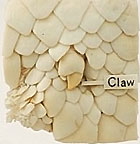
From one species to another...
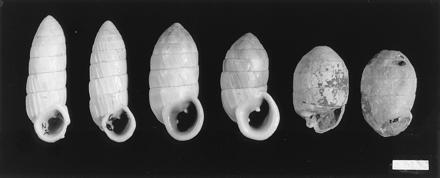
Otter: Okay -- I'm new to all this, but I'm not sure what this proves! First, I don't know that these pictures are not altered or doctored up, but I'll assume that you are honest and they show what you say they do.
This still doesn't prove anything -- the Bible says in Genesis 3:14 that snakes had legs once upon a time.
Also, how do you know this is proof of past evolution instead of evolution into a new species?
Okay, so assuming all this -- you have a snake with legs. It's still a snake. If you breed it with a snake you get ------- A SNAKE! Wow, what a concept. Even if it grew 14 legs it would still be a snake. It's parents were snakes. Where does the not snake part come in.
Finally, and please excuse my ignorance, because I'll admit I don't know much about any of this. What is that last picture? I have no idea what those things even are, much less what they are supposed to prove.
Thanks
The shells demonstrate much the same pattern as was found in the evolution of whales. (Snakes may have evolved from Lizards --- that's when the no-longer-lizard-kind, becomes snake-kind).
"... Dinilysia, discovered from the Cretaceous of Argentina, "has inspired and challenged efforts to understand snake origins. The single well-preserved skull exhibits such a blend of snakelike, lizardlike, and unique characteristics that herpetologists still argue about whether this creature was indeed a snake" (Greene 1997)."
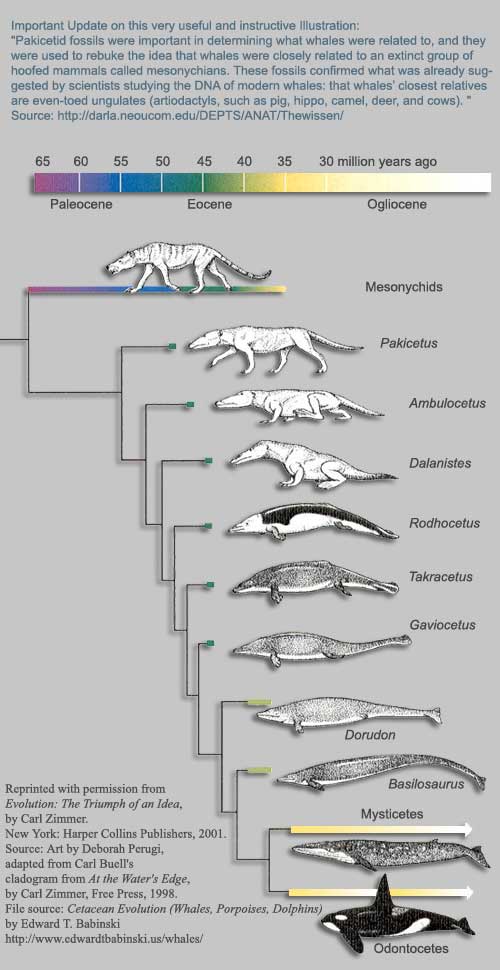
For more information : Cetacean Evolution (Whales, Porpoises, Dolphins)
by Edward T. Babinski


Live bearing snakes are considered to be higher on the evolutionary chain than those that lay eggs.
ReplyDeleteKitchen Countertops Long Island